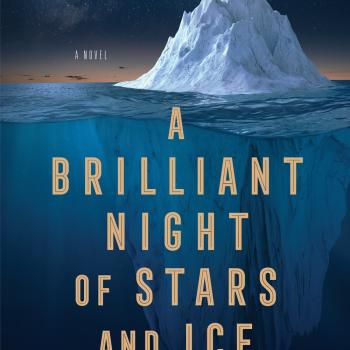 In our hyper-digital age of shorter and shorter missives communicated through fewer and fewer strokes, a friendship sustained and deepened through long, handwritten letters is an extraordinary act of love and faith. Love & Salt: A Spiritual Friendship in Letters, is an achingly beautiful new book chronicling the friendship between two young Catholic women over a five year span, as they make sense of their daily lives — marriage, career, Church, pregnancy, motherhood, and tragic loss — through the lens of faith. The resulting letters – each a deep soul dive that leaves you savoring, while yearning for the next – reveals an exquisite, honest, heart-breaking and ultimately hopeful portrait of two lives deeply lived, contemplated, shared, and redeemed in the context of the search for God.
In our hyper-digital age of shorter and shorter missives communicated through fewer and fewer strokes, a friendship sustained and deepened through long, handwritten letters is an extraordinary act of love and faith. Love & Salt: A Spiritual Friendship in Letters, is an achingly beautiful new book chronicling the friendship between two young Catholic women over a five year span, as they make sense of their daily lives — marriage, career, Church, pregnancy, motherhood, and tragic loss — through the lens of faith. The resulting letters – each a deep soul dive that leaves you savoring, while yearning for the next – reveals an exquisite, honest, heart-breaking and ultimately hopeful portrait of two lives deeply lived, contemplated, shared, and redeemed in the context of the search for God.
We invited Jess and Amy to respond to some questions about the letters, their friendship, and the decision to share it all in a book.
What inspired your letter-writing to each other?
 Jess: We were just getting to know each other when we both moved away from Pittsburgh. Neither of us had a very good track record with long-distance relationships. Since we had initially bonded by reading each other’s writing about faith, it made sense to continue the friendship through writing. We loved the idea of it, writing these old-fashioned letters rather than emails or phone calls.
Jess: We were just getting to know each other when we both moved away from Pittsburgh. Neither of us had a very good track record with long-distance relationships. Since we had initially bonded by reading each other’s writing about faith, it made sense to continue the friendship through writing. We loved the idea of it, writing these old-fashioned letters rather than emails or phone calls.
 Amy: I actually have a hard time remembering exactly how we cooked up the idea, I just know how thrilling it felt – like we were heading out on the road to Compostela. Very early on in our friendship we started devising mini-pilgrimages: a trip to see the relics at St. Anthony’s in Pittsburgh, a trek out to Flannery O’Connor’s farm in Georgia, or a weekend at a Trappist monastery. That’s how this letter-writing project felt, like we were at the start of a quest, and the romance of it – being wayfarers on the road to something sacred – enchanted us.
Amy: I actually have a hard time remembering exactly how we cooked up the idea, I just know how thrilling it felt – like we were heading out on the road to Compostela. Very early on in our friendship we started devising mini-pilgrimages: a trip to see the relics at St. Anthony’s in Pittsburgh, a trek out to Flannery O’Connor’s farm in Georgia, or a weekend at a Trappist monastery. That’s how this letter-writing project felt, like we were at the start of a quest, and the romance of it – being wayfarers on the road to something sacred – enchanted us.
When you began your letters to each other, did you ever imagine it would last nearly five years? What was it about the process of writing to each other that kept it going so long after the initial commitment?
Jess: I don’t know that we would have seen it through if we hadn’t decided to make it a Lenten commitment—one letter for every day of that first Lent. I hear that it takes at least a month of daily repetition to form a new habit. We were definitely hooked before the end of that Lent. At that point, I couldn’t imagine life without them.
Amy: I once read in a review of the collected letters of William and Henry James that their letters were not only the form their intimacy took, but also the very medium of their thinking, being and spiritual experience. Somehow the abstract or the unseen never becomes real for me if I am left alone with my own thoughts. Writing to Jess returns me to life. So, of course, once I discovered this during our first Lent, I couldn’t let our letters go.
How is your friendship different from the other relationships in your lives, because of the letters?
Jess: Amy has written that it’s almost like we have two friendships—the one where we visit each other and talk on the phone about our kids and husbands and daily lives, like all friends do, and then, the friendship of our letters, where we try to understand our daily lives in relationship to God. I once handed her a letter in person, and we both realized that we felt a little shy about it. Amy described it as like meeting her secret correspondent for the first time. For me it was like seeing my confessor face to face after I’d poured out all my sins and doubt behind the screen.
What really makes our friendship different, though, is that it’s a spiritual friendship. We came together to seek God, and that search is really the foundation, the thing that our friendship is “about.” I want to add that “spiritual” here does not mean our friendship is always high or good or pure. We struggle with the same things – jealousy, competition, paranoia – that all friendships contend with. It’s just that what’s at the heart of our friendship – our search for God – has the power to redeem us. I think that’s one of the real satisfactions of our story.
Amy: I think letter writing made an ongoing intimacy between us more possible. Often the initial phase of friendship (either a romantic or platonic one) is so intense because you are trying to give yourself to the other person through storytelling. But eventually you’ve told most of your stories; you feel that you know each other. At this point it is often hard for intimacy to continue to deepen. If you open your heart anew or try to be something new, you worry this person who knows you so well will see through the attempt. But our letters offered a way of talking – almost like whispering in the dark – that kept our intimacy fresh, even when the going got rough.
 Mid-way through the book, Amy says: “The arrival of a letter is often the only sacramental thing in my day … We press God out in the pages of our letters, ironing and ironing, like two old-fashioned women. We mail him back and forth, and pile him up, like a basket of linen.” Can you say more about the sacramental nature of your letters?
Mid-way through the book, Amy says: “The arrival of a letter is often the only sacramental thing in my day … We press God out in the pages of our letters, ironing and ironing, like two old-fashioned women. We mail him back and forth, and pile him up, like a basket of linen.” Can you say more about the sacramental nature of your letters?
Amy: When you love someone that love is largely invisible. Children are a physical manifestation of marital love, but not every friendship can have an obvious physical sign of its unity. When I get a letter from Jess, I feel like I’m holding a real artifact from that unseen bond. I remember Jess writing to me about receiving her Grandmother’s letters in a box. She poured over them, treasured them, held them gently. Goethe once said that letters are “the most immediate breath of life.” With a letter in hand, you have the sense that your friend is with you, present in her words. It’s not only the physicality of the letter itself, the unique quality of the handwriting, but the mysterious connection between word and person that creates that sacramental feel.
Your letters are deeply honest and expressive of a full range of emotion — joy, doubt, hope, boredom, despair, ecstasy. You write candidly about your husbands, parents, in-laws, children, co-workers and friends. How did you decide to allow these very personal letters to become a book to be shared with hundreds of readers? What was that discernment process like for each of you?
Jess: It was, and is, hard. But as a writer, especially a writer of personal essay and memoir, I’ve had to accept that it comes with the territory. Plus we felt that the honesty and the candidness, the authenticity, of the letters was one of their chief virtues.
Amy: I agree – it was very hard. In fact after we finished editing the letters into a book-length manuscript, we shelved the final draft for almost two years before sending it to Loyola Press. One of the things that helped us get over our trepidation was the book Looking Before and After by Alan Jacobs. He urges Christians to tell their stories in order to flesh out the various forms, or genres, the Christian life might take. By doing this, Jacobs thinks, we help each other avoid despair and resignation on the road to God, offering each other a vision of hope. This helped us move forward, for we were fairly confident that if nothing else our story succeeded in fleshing out a particular way to God – the way of friendship. And since so little these days is written about serious friendship between women, or serious friendship period, we thought it could be a real contribution.
A theme revisited often in your letters is summed up in this question from Jess: “Are we missing our lives by obsessing over our souls?” How would you answer that question now? Have you found the balance between living and contemplation?
Jess: Ultimately we realized that our letters had the opposite effect. They came to be the way that we savored experience—a way to suspend time, one of our common obsessions. Often it was only in writing and reflecting on my days, and many times my days long past, that I uncovered the deeper meaning that of course had been there all along.
Amy: I think about that tie between contemplation and living all the time. I keep coming across advice from psychologists to keep a gratitude journal, which is another way of contemplating life. They tell us this will lead to happiness. I’ve been trying to make sense of our letters in light of all this. I feel like our correspondence is the dark, brooding cousin of the gratitude journal. In a similar way our letters purposefully frame life on a daily basis, but they are certainly not a consistent record of happiness. Sometimes we do record happy moments, but those moments are never what I feel is most profound about our practice. What I see instead is the movement through periods of bleakness, doubt and grief that eventually reveals a retrospective vision of God’s grace, pervasive through all those times. In the end it was not so much happiness, but hope our letters gave us.
Another crucial theme that persists throughout your letters is the fear of death. What ultimately sustained you through the real and imagined experiences of death in your lives?
Jess: I almost said grace, but often we can’t perceive the workings of grace during those intense periods of grief that follow the death of someone we love. In the face of death, I, personally, felt totally abandoned, and that nothing was real but death. So, really, what sustained us was the cross, the belief that God became man and faced even this, and that even this did not end his love.
Amy: I’m so glad you brought this up. I definitely agree that an awareness of death was at the center of our letters and of our friendship. The question of how to believe in the face of mortality is really what focused our correspondence. And this focus is responsible more than anything else for our letters becoming a book. We never set out to write a story, and in fact most collections of letters are an assemblage and have no narrative drive. But because there was a single question at the heart of our correspondence and because in the middle of those years we encountered a real tragedy, our letters became a story. And I agree with Jess, the revelation of our story – and the thing that sustained us – was the cross, which includes the resurrection. In the end we discovered a hope beyond death, which was the answer our question traveled into.
You both are beautiful writers … how did the act of letter writing change, shape or grow you as a writer?
Jess: It’s just a different writing experience than any other form. It’s not public, but it’s not private either, like keeping a journal or a diary. You’re still accountable to an audience, only that audience is just one soul. You don’t have to worry about pleasing everyone (or as many as you can), as you inevitably do with any form of public writing. It’s that peculiar middle, not public, not totally private, that makes letters so fascinating to me. It was also pretty instructive and inspiring to be getting these beautiful, profound letters from Amy in the mail every day. I definitely grew as a writer and thinker just from being in conversation with her in this way.
Amy: When you write a letter, you imagine the presence of a receptive world beyond the self. It’s the same act of faith required to create any piece of writing or, for that matter, to pray. And it’s really a desire for response. When that response actually comes in an envelope in the handwriting of a friend, it shores you up for the hard work of writing, and of praying. I’ve learned so much about both writing and prayer from my correspondence with Jess. It actually seems I’m quite incapable of both when our letters have lapsed.
Were there periods of time that your letter writing slowed? How did you decide to eventually stop altogether?
Jess: We haven’t stopped! We keep telling each other that. This Lent we are committing again to a letter a day. Kids definitely slowed us down, though, I’m not gonna lie. I used to write with Charlotte asleep in my lap. She’s seven now, and she and her little brother want me to play Hobbits every waking hour. And they require much less sleep than I do.
There was one time when we really did stop writing, and that’s when Amy moved to Sweet Briar for nine months. We lived around the corner from each other on the college campus. For the first time in our friendship, I saw her every day. We tried to devise ways to keep up the letter writing—we even tried to give up seeing each other for Lent. But we just couldn’t make it work. That was the greatest consolation when she had to move away: we knew we’d get our letters back.
What was the hardest part of writing letters to each other? And what was the greatest gift to each of you in the exchange of your letters?
Jess: The hardest part of writing letters was carving out that bit of time every day to write them. It became even harder with small children around to find that space for contemplation, and it’s painful, because there’s so much that I want to recall and preserve and explore about life with children.
The greatest gift was friendship, and the discovery that friendship, as the 12th century monk Aelred of Rievaulx wrote, is where God abides.
Amy: I just want to add one thing. In his book Spiritual Friendship, which we discovered long after we began writing our letters, Aelred says that finding God in friendship gives us a foretaste of eternity. In this life, he says, we are called upon to love everyone, even our enemies, but only in friendship do charity and sweetness come together. It is this foretaste of eternity, I think, that is the real gift our letters gave us. We spend much of the book confronting mortality and seeking God’s providence, but in the end the revelation of eternal life – abiding, as Jess said, in our friendship – is the real presence we discover.
What’s next for each of you? What projects are you currently working on/inspired by?
Amy: We’re both working on other memoirs. And of course, we’re still writing letters!
 For more conversation on Love & Salt – and to read an excerpt, watch a video Q&A, and hear the authors reading their letters aloud – visit the Patheos Book Club here.
For more conversation on Love & Salt – and to read an excerpt, watch a video Q&A, and hear the authors reading their letters aloud – visit the Patheos Book Club here.













